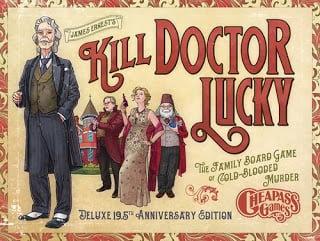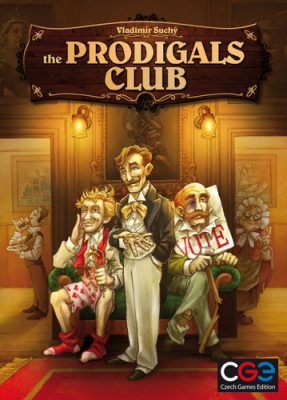Not all games want you to solve the murder or score the most points. Some take a "sinister" approach and want you to commit the murder or lose the most points. Check these games out and see if they might be something for your next Family Game Night.
[Tweet "Expect the unexpected: 2 #boardgames with a twist! Review by @stuartsstudy"]

One of the very first games that I remember playing a child was Clue. At the time, I thought it was a very clever game of deduction and problem solving. While I still own a copy and will occasionally play it, I have moved on to different games. Recently, I was introduced to a game called Kill Doctor Lucky. On the surface, Clue and Kill Doctor Lucky have a lot in common. They both have a mansion, a murder, and colorful players/pawns. However, the two games are VASTLY different. In Clue, you are trying to solve the murder. In Kill Doctor Lucky, you are trying to commit the murder. Kill Doctor Lucky has recently been re-released in a Deluxe 19.5 Anniversary Edition. It is designed for 2-8 players, ages 12+. It takes about 30-45 minutes to play and retails for $40.
Review
If you are a fan of The Simpsons, like myself, you are very familiar with the evil billionaire C. Montgomery Burns. When they did an episode about him being shot, everyone was a suspect, because he was so universally disliked. Kill Doctor Lucky made me immediately think of this episode. If you read your character card, you will see that Doctor Lucky has harmed all the people in some humorous way or another. One guy wants to kill him because he gave away the secret to his magic trick. A paperboy wants to kill him because he is weeks behind on payment. All of them are nonsense, in a funny way. However, he is called Doctor Lucky for a reason, and the reason is that he is just so hard to kill. When you do finally get him alone in a room to attempt the murder, you will most likely fail your first several attempts because other people are trying to foil you. Yes, they want him dead, but they want to be the one to do it.
The game smacks of flavor text on every card. The humor is a mix of subtle, corny, and silly, so there is something for everyone. The game play itself is simple to learn, and the board is not only double-sided but scales well, no matter the number of players. It does this by playing with fewer rooms and/or adding in Doctor Lucky's pets, which make it a bit more challenging to kill the miserable old man. Now, I don't condone murder at all, but after playing through this game several times, it is clear to me why this game has a cult following and has stood the test of time for 20 years. The game is a clear spoof of Clue, doesn't take itself too seriously, and has a high replay value. Unfortunately for me, my wife didn't like the game as much as I did, but I'm hoping I can get her to play it a few more times and win her over. If you like this game and want even more variety, check out the expansion called the Secret Lair of Doctor Lucky, which gives you an alternate board with a spy theme.

In order to be a "proper gentleman," you must hold public office, not squander your money, and speak politely at formal dinners. In summation, you must be an absolute stick-in-the-mud. After years of being absolute bores, you and a group of friends have decided to cut loose and have some fun and create The Prodigals Club. The Prodigals Club is a secret fraternity of young gentlemen trying to tick off the upper crust of society as much as possible. They will do this by losing votes in an election, getting rid of everything they own, and infuriating as many influential people as possible. The Prodigals Club is a game for 2-5 players, aged 14+. It takes 40-90 minutes to play and retails for $49.95.
Review
The Prodigals Club is a medium-weight worker placement and hand management style game with a bit of an economic theme. However, the twist in this game is that you are trying to lose points, not gain points. The fact that you are trying to lose points messed with me a couple of times, because it goes against everything I know about gaming. What I really like best about this game is that it is condensed to five rounds. That doesn't sound like a lot, but it is an action-packed five rounds of trying to build your engine efficiently and then destroy it at just the right moments. The theme doesn't always come through with everything you are doing, but it has a strong enough presence that with a little effort on your part and some fake accents, you can make it a funny experience.
As with all Czech Games Edition products, the components in this game are of high quality. You aren't just putting cubes on a board, but placing elegant top hats. The cards are also superb, because the illustrations are very hoity-toity in a good way. I also liked the replay value of this game. With three modules, you can mix and match which two you play with and give yourself three different variations to play with, or if you are feeling brave, go for all three! The game is also a standalone prequel to Last Will, and if you want an even more ambitious game, it is able to be combined with Last Will.
Where this game suffered for me was the time it takes to play it. Unfortunately for me, my game group seems to be made up of people who suffer from analysis paralysis. The game itself is straight-forward, as are the moves, but you are presented with a lot of choices that can make some very interesting combos. Because of these choices and the analysis of combos, it's no wonder people can overthink this game. The game can play up to five players, but I generally only play it with two because I don't want a game to go on forever. This isn't necessarily a criticism of the game, more a tip to be aware of who you will play it with. So if you are looking for a worker placement game with a somewhat sinister/mischievous theme and a unique scoring system, I invite you to check out The Prodigals Club.
Copyright 2016 Stuart Dunn
About the Author

Stuart Dunn
Stuart Dunn was born and raised in Mobile, AL and received a Bachelor of Arts in Psychology and a Master of Business Administration from the University of South Alabama. Stuart reviews all things Catholic including adult books, children’s books, Bible Study series, Catholic Courses, CDs, and DVDs in addition to board games at his blog Stuart’s Study at StuartsStudy.blogspot.com.


.png?width=1806&height=731&name=CatholicMom_hcfm_logo1_pos_871c_2728c%20(002).png)
Comments